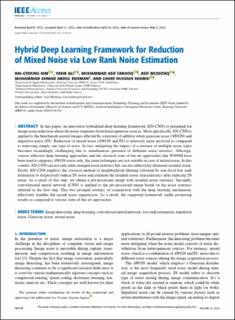| dc.contributor.author | Kim, Dai-Gyoung | |
| dc.contributor.author | Ali, Yasir | |
| dc.contributor.author | Farooq, Muhammad Asif | |
| dc.contributor.author | Mushtaq, Asif | |
| dc.contributor.author | Rehman, Muhammad Ahmad Abdul | |
| dc.contributor.author | Shamsi, Zahid Hussain | |
| dc.date.accessioned | 2022-12-05T13:32:47Z | |
| dc.date.available | 2022-12-05T13:32:47Z | |
| dc.date.created | 2022-05-07T07:13:35Z | |
| dc.date.issued | 2022 | |
| dc.identifier.citation | Kim, D., Ali, Y., Farooq, M. A., Mushtaq, A., Rehman, M. A. A. & Shamsi, Z. H. (2022). Hybrid Deep Learning Framework for Reduction of Mixed Noise via Low Rank Noise Estimation. IEEE Access, 10, 46738-46752. doi: | en_US |
| dc.identifier.issn | 2169-3536 | |
| dc.identifier.uri | https://hdl.handle.net/11250/3035899 | |
| dc.description.abstract | In this paper, an innovative hybridized deep learning framework (EN-CNN) is presented for image noise reduction where the noise originates from heterogeneous sources. More specifically, EN-CNN is applied to the benchmark natural images affected by a mixture of additive white gaussian noise (AWGN) and impulsive noise (IN). Reduction of mixed noise (AWGN and IN) is relatively more involved as compared to removing simply one type of noise. In fact, mitigating the impact of a mixture of multiple noise types becomes exceedingly challenging due to simultaneous presence of different noise statistics. Although, various effective deep learning approaches and the classical state-of-the-art approaches like WNNM have been used to suppress AWGN noise only, the same techniques are not suitable in case of mixed noise. In this context, EN-CNN can not only infer changed noise statistics but can also effectively eliminate residual noise. Firstly, EN-CNN employs the classical method of neighborhood filtering followed by non-local low rank estimation to respectively reduce IN noise and estimate the residual noise characteristics after reducing IN noise. As a result of this step, we obtain a pre-processed image with residual noise statistics. Secondly, convolutional neural network (CNN) is applied to the pre-processed image based on the noise statistics inferred in the first step. This two pronged strategy, in conjunction with the deep learning mechanism, effectively handles the mixed noise suppression. As a result, the suggested framework yields promising results as compared to various state-of-the-art approaches. | en_US |
| dc.language.iso | eng | en_US |
| dc.rights | Navngivelse 4.0 Internasjonal | * |
| dc.rights.uri | http://creativecommons.org/licenses/by/4.0/deed.no | * |
| dc.title | Hybrid Deep Learning Framework for Reduction of Mixed Noise via Low Rank Noise Estimation | en_US |
| dc.title.alternative | Hybrid Deep Learning Framework for Reduction of Mixed Noise via Low Rank Noise Estimation | en_US |
| dc.type | Peer reviewed | en_US |
| dc.type | Journal article | en_US |
| dc.description.version | publishedVersion | en_US |
| dc.rights.holder | © 2022 The Author(s) | en_US |
| dc.source.pagenumber | 46738-46752 | en_US |
| dc.source.volume | 10 | en_US |
| dc.source.journal | IEEE Access | en_US |
| dc.identifier.doi | 10.1109/ACCESS.2022.3170490 | |
| dc.identifier.cristin | 2022327 | |

